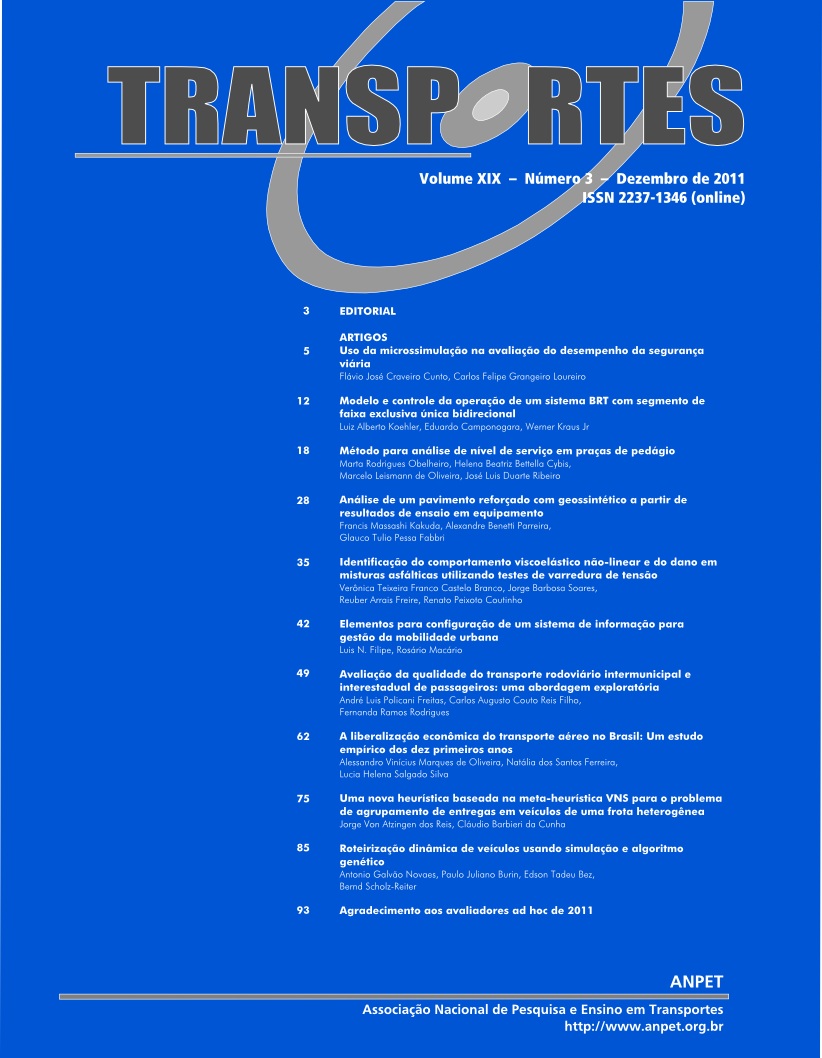Análise de um pavimento reforçado com geossintético a partir de resultados de ensaio em equipamento de grandes dimensões
DOI:
https://doi.org/10.14295/transportes.v19i3.532Resumo
Resumo: O artigo analisa o beneficio do uso de uma geogrelha como reforço da camada de base de um pavimento. Seções do pavimento e subleito com dimensões próximas às reais submetidas a carregamentos cíclicos foram ensaiadas numa caixa metálica quadrada com lado de 1,5 m e altura de 1,2 m. Concluiu-se que a utilização da geogrelha proporciona a redução de deformações elásticas e permanentes, e que a eficiência do reforço posicionado na interface com o subleito é maior que a do reforço posicionado no horizonte médio da base. Foram ainda determinados os módulos de resiliência da base e do subleito a partir da retroanálise das bacias de deflexões obtidas nos ensaios. Finalmente, a análise numérica de um pavimento hipotético mostrou que a geogrelha pode proporcionar uma extensão expressiva na vida de fadiga do revestimento asfáltico.
Palavras-chave: pavimentos reforçados com geosintéticos, geogrelha, ensaios de laboratório em verdadeira grandeza, deformações elásticas e plásticas sob carregamento cíclicos.
Abstract: The article analyzes the benefits of the application of a geogrid as base layer pavement reinforcement. Cyclic loaded fullscale sections of pavement and subgrade were tested in a square metallic box with 1.5 m width and 1.2 m height. It was concluded that the geogrid reduces the elastic and plastic deformations and also that positioning the reinforcing at subgrade interface is more efficient than at base medium horizon. The base and subgrade resilient modulus were obtained by back calculation using the deflection basin results from the tests. Finally, a numerical modeling of a hypothetic pavement showed that the geogrid may conduct to an expressive increase of the bituminous surface life.
Keywords: geosynthetic reforced pavement, geogrid, full-scale laboratory tests, elastic and plastic deformation under cyclic loadings.
Downloads
Downloads
Publicado
Como Citar
Edição
Seção
Licença
Ao submeter um manuscrito para publicação neste periódico, todos os seus autores concordam, antecipada e irrestritamente, com os seguintes termos:
- Os autores mantém os direitos autorais e concedem à Transportes o direito de primeira publicação do manuscrito, sem nenhum ônus financeiro, e abrem mão de qualquer outra remuneração pela sua publicação pela ANPET.
- Ao ser publicado pela Transportes, o manuscrito fica automaticamente licenciado sob a Licença Creative Commons CC BY 4.0. Esta licença permite o seu compartilhamento com reconhecimento da autoria e da publicação inicial neste periódico.
- Os autores têm autorização para assumir contratos adicionais separadamente, para distribuição não exclusiva da versão do trabalho publicada neste periódico (por ex.: publicar em repositório institucional ou como capítulo de livro), com reconhecimento da publicação inicial na Transportes, desde que tal contrato não implique num endosso do conteúdo do manuscrito ou do novo veículo pela ANPET.
- Os autores têm permissão e são estimulados a publicar e distribuir seu manuscrito online (por ex.: em repositórios institucionais ou na sua página pessoal) depois de concluído o processo editorial. Como a Transportes é de acesso livre, os autores são estimulados a usar links para o DOI do artigo nesses casos.
- Os autores garantem ter obtido a devida autorização dos seus empregadores para a transferência dos direitos nos termos deste acordo, caso esses empregadores possuam algum direito autoral sobre o manuscrito. Além disso, os autores assumem toda e qualquer responsabilidade sobre possíveis infrações ao direito autoral desses empregadores, isentando a ANPET e a Transportes de toda e qualquer responsabilidade neste sentido.
- Os autores assumem toda responsabilidade sobre o conteúdo do manuscrito, incluindo as devidas e necessárias autorizações para divulgação de dados coletados e resultados obtidos, isentando a ANPET e a Transportes de toda e qualquer responsabilidade neste sentido.










